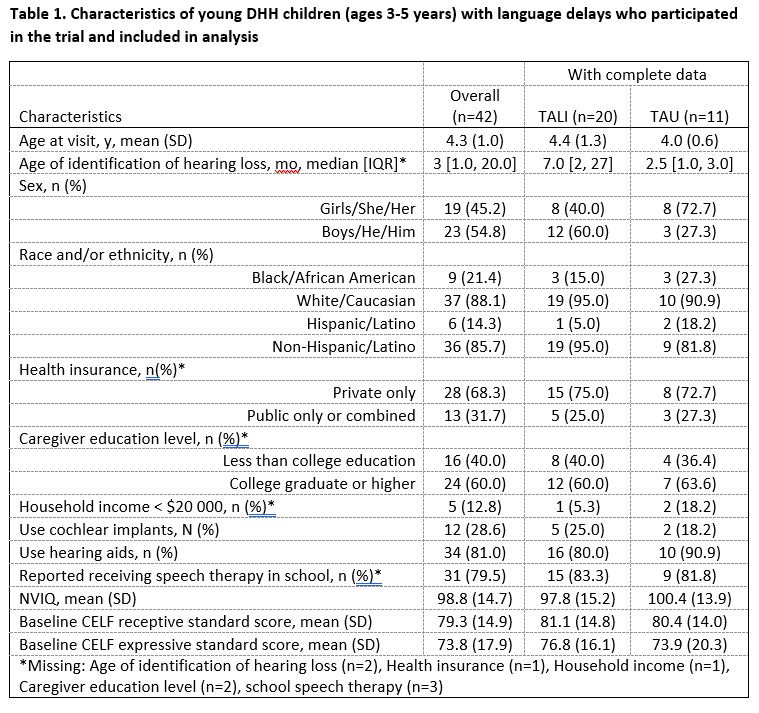Developmental and Behavioral Pediatrics: Developmental Disabilities
Developmental and Behavioral Pediatrics 4
419 - Pre-literacy skills in children who are deaf/hard of hearing (DHH): secondary analysis of the Technology-Assisted Language Intervention (TALI) randomized trial
Saturday, April 29, 2023
3:30 PM - 6:00 PM ET
Poster Number: 419
Publication Number: 419.207
Publication Number: 419.207
Elodie Betances, Cincinnati Children's Hospital Medical Center, Cincinnati, OH, United States; Meredith E. Tabangin, Cincinnati Children's Hospital Medical Center, Cincinnati, OH, United States; Susan Wiley, Cincinnati Children's Hospital Medical Center University of Cincinnati, Cincinnati, OH, United States; Rose M. Sheldon, CCHMC, Cincinnati, OH, United States; Jareen Meinzen-Derr, Cincinnati Children's Hospital Medical Center, Cincinnati, OH, United States; Laura Lane, Cincinnati Children's Hospital Medical Center, Cincinnati, OH, United States

Elodie M. Betances, MD FAAP (she/her/hers)
DDBP Fellow
Cincinnati Children's Hospital Medical Center
Cincinnati, Ohio, United States
Presenting Author(s)
Background: The TALI, a speech-language therapy using augmentative and alternative communication technology as a language teaching tool, has been shown to significantly improve language skills over treatment as usual (TAU) therapy. It is unknown if this improvement is linked to early literacy. By preschool age, most children display preliteracy skills (exploring books, recognize letters, retell stories). DHH children with language delays are at risk for delayed preliteracy skills
Objective: To describe preliteracy skills in young DHH children with language delays and investigate if TALI also affects preliteracy in DHH preschoolers.
Design/Methods: This study used data collected from DHH children (3-10yrs) with identified language delays enrolled in 1 of 2 randomized trials (2016-present) to improve language. Children were randomized to receive either TALI or TAU for 24 wks. Language assessments included the Preliteracy Rating Scale (PRS) from Clinical Evaluations of Fundamentals-Preschool occurred at baseline and 24 weeks for DHH children age 3-5 yrs. The parent-report profile items are answered Always, Often, Sometimes, Never completed, scored numerically with cutoffs for age-appropriate skills. Logistic regression evaluated factors associated with having age-appropriate skills. Multiple regression evaluated factors associated with PRS score improvements while controlling for confounders.
Results: To date, 42 DHH children (mean age 4.3y, range 3-5), participated in the trial; 31 with completed pre-and post-data (20 TALI, 11 TAU). Baseline characteristics (race, sociodemographic factors, maternal education level, degree of hearing loss, age of identification) were similar between groups (Table 1). At baseline, 52% of DHH children had age appropriate preliteracy skills, increasing to 68% at 24wks. Logistic regression results indicated that higher expressive language scores were associated with age-appropriate skills at 24wks (OR 1.4 95% CI 1.1, 1.8). TALI vs TAU were more likely to have appropriate skills, though not significant (OR 2.1, p=0.4). No other factors (IQ, SES, age, receptive language) were associated. Regression models of PRS scores over time had similar results with a 28% increase in scores pre to post intervention (p< 0.0001).
Conclusion(s): In our sample, language delays in DHH children seem to negatively impact preliteracy skills. TALI may have an advantage of improving preliteracy skills by significantly improving language performance. This enhances our understanding of a link between language intervention and literacy. Further research is needed to better support DHH children’s literacy development.

